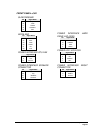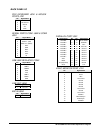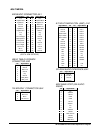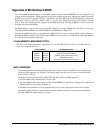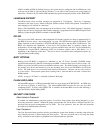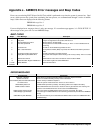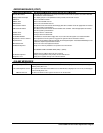
Advanced/RH Technical Product Specification •• Page 41
APM is enabled in BIOS by default, however, the system must be configured with an APM driver (such
as Power.exe for DOS or vpowerd.386 for Windows 3.x) in order for the system power saving features to
take effect. Windows 95 will enable APM automatically upon detecting the presence of the APM BIOS.
LANGUAGE SUPPORT
The BIOS setup screen and help messages are supported in 32 languages. There are 5 languages
translated at this time for use; American English, German, Italian, French, and Spanish. Translations of
other languages will available at a later date.
With a 1 Mb Flash BIOS, only one language can be resident at a time. The default language is American
English, and will always be present unless another language is programmed into the BIOS using the Flash
Memory Update Program (FMUP) available on the Intel BBS.
PCI IDE
The two local bus IDE connectors with independent I/O channel support are setup up automatically by
the BIOS if the user selects “Autoconfiguration” in setup. The IDE interface supports PIO Mode 3 and
Mode 4 hard drives and recognition of ATAPI CD-ROMs, tape drives, and any other ATAPI devices. The
BIOS will determine the capabilities of each drive and configure them to optimize capacity and
performance. For the high capacity hard drives typically available today, the drive will be automatically
configured for Logical Block Addressing (LBA) for maximum capacity and to PIO Mode 3 or 4
depending on the capability of the drive. The user is able to override the auto-configuration options by
using the manual mode setting.
BOOT OPTIONS
Booting from CD-ROM is supported in adherence to the “El Torito” bootable CD-ROM format
specification developed by Phoenix Technologies and IBM. Under the Boot Options field in setup, CD-
ROM is one of four possible boot devices defined in priority order. The default setting is for floppy to be
the primary boot device and hard drive to be the secondary boot device and CD-ROM to be the third
device. The forth device is set to disabled in the default configuration.. The user can also select network
as a boot device. The network option allows booting from a network add-in card with a remote boot
ROM installed.
NOTE: A copy of “El Torito” is available on Phoenix Web page.
FLASH LOGO AREA
Advanced/RH supports a 4 KB programmable flash user area located at EC000-ECFFF. An OEM may
use this area to display a custom logo. The Advanced/RH BIOS accesses the user area just after
completing POST. A utility called USRLUTIL is available on the Intel BBS to assist with installing a
logo into flash for display during POST.
SECURITY FEATURES
Administrative Password
If enabled, the administrative password protects all sensitive Setup options from being changed by a user
unless the password is entered. Without the proper password the user will be able to configure only the User
password and the power management hot key fields. The User password does not alter the protection
provided by the Administrative password.
User Password
The User Password feature provides security, preventing the system from booting or entering setup unless the
user selected password is entered during the boot process,. The user password can be set using the Setup
utility, and must be entered prior to peripheral boot or keyboard/mouse operation.



